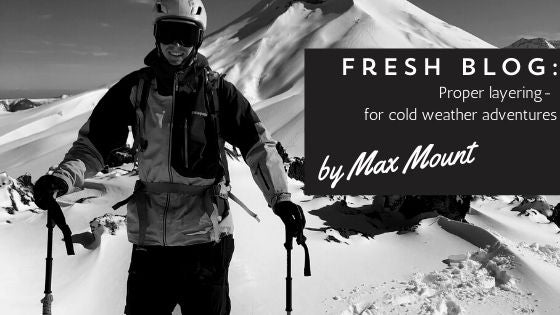Your Cart is Empty
accepting gear drop offs Mon-Sat 10am-5pm. No Consignment acceptance on Sundays.
accepting gear drop offs Mon-Sat 10am-5pm. No Consignment acceptance on Sundays.

Proper Layering
When it comes to cold weather adventure from snowshoeing behind the house to multi-day epics in Alaska’s mountain ranges, proper layering is the key to having fun and staying safe in the wintery outdoors. This is a quick and easy guide to get you out in the cold dressed like a pro.
Base Layers
The first layer to think about when getting ready for a cold-weather adventure is the layer of clothing against your skin. The first rule of base layers is to AVOID ALL COTTON. Cotton has no moisture-wicking properties so as you sweat, a cotton t-shirt or underwear holds that moisture against your skin and makes you cold. The best base layers are synthetic or wool. A synthetic or wool base layer pushes the moisture away from your skin allowing you to stay dry and warm. This is the same for your legs. Using synthetic or wool tights is the best way to stay warm.

Mid Layers.
Mid-layers are fully dependent on the weather conditions and where the true warmth comes from. On an average weather day, a light puff is the perfect mid-layer. This will help retain your body heat and keep you warm. For colder weather days a larger puffy will retain more heat. Generally, for legs, a mid-layer is not necessary unless in truly frigid temperatures. As most of your body heat is emitted from your core, keeping your core warm is the most important part.

Outer layer
The outermost layer is less for retaining heat and more for keeping the elements out. This is where materials like Gore-Tex come into play. A water/ windproof layer is a key element to proper layering, Keeping you dry and warm regardless of what the weather does. The other key to outer layers is when traveling uphill remember to remove the layer so it does not trap moisture on the inside of the jacket. But when you stop uphill travel the first thing you should do is put your outer layer to keep the heat you just generated from dissipating.

Accessories
Accessories such as hats, gloves, and socks are just as important as a good jacket. Starting at the top and going down a good warm hat is a great way to help stay warm. Hats are very straightforward and a fancy merino wool hat is not necessary. Just something to keep the head warm is the goal. Gloves are another very important part of a good cold weather kit. Having a nice pair of waterproof gloves will allow your hands to happily function in colder weather. There are no major performance differences between gloves and mittens except mittens tend to be slightly warmer. When it comes to socks having a nice high-end pair of wool or synthetic socks makes a huge difference in how warm your feet stay. Changing socks often is key. Damp socks lead to cold feet. Having warm comfortable feet is a make or break on a cold-weather adventure.


Thanksgiving is almost here–and skiing this early is always a gamble. Here are some non-skiing warm(er) weather destination ideas for the long break.

Just a couple hours from Durango, Valles Caldera is a great cross-country skiing destination, with surprisingly good snow and very few visitors.
Valles Caldera National Preserve is a popular hiking destination in the summer and a surprisingly great skiing destination in the winter.

When spending one night (or many) in the backcountry, a warm dinner at night and hot beverage in the morning can make the difference. That invariably involves using a stove of some sort–but which one?
Stove technology has been around for decades, but new tech is making them lighter, more efficient, and more dependable than ever before. Here’s a rundown of the different kinds of backpacking stoves: